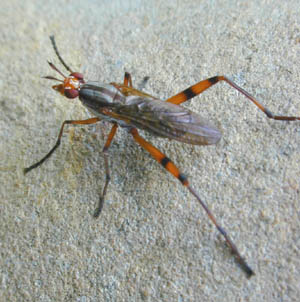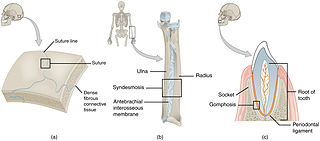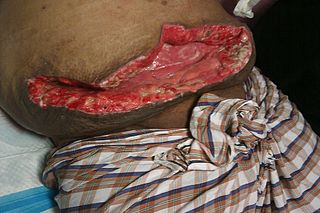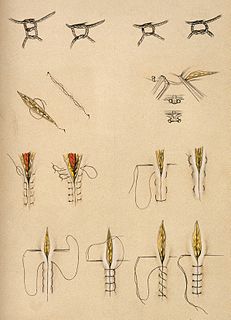
A fontanelle is an anatomical feature of the infant human skull comprising soft membranous gaps (sutures) between the cranial bones that make up the calvaria of a fetus or an infant. Fontanelles allow for stretching and deformation of the neurocranium both during birth and later as the brain expands faster than the surrounding bone can grow. Premature complete ossification of the sutures is called craniosynostosis.

Forceps are a handheld, hinged instrument used for grasping and holding objects. Forceps are used when fingers are too large to grasp small objects or when many objects needed to be held at one time while the hands are used to perform a task. The term "forceps" is used almost exclusively in the fields of biology and medicine. Outside biology and medicine, people usually refer to forceps as tweezers, tongs, pliers, clips or clamps.

The Schizophora are a section of true flies containing 78 families, which are collectively referred to as muscoids, although technically the term "muscoid" should be limited to flies in the superfamily Muscoidea; this is an example of informal, historical usage persisting in the vernacular. The section is divided into two subsections, the Acalyptratae and Calyptratae, which are commonly referred to as acalyptrate muscoids and calyptrate muscoids, respectively.

Polyglycolide or poly(glycolic acid) (PGA), also spelled as polyglycolic acid, is a biodegradable, thermoplastic polymer and the simplest linear, aliphatic polyester. It can be prepared starting from glycolic acid by means of polycondensation or ring-opening polymerization. PGA has been known since 1954 as a tough fiber-forming polymer. Owing to its hydrolytic instability, however, its use has initially been limited. Currently polyglycolide and its copolymers are widely used as a material for the synthesis of absorbable sutures and are being evaluated in the biomedical field.

A surgical instrument is a tool or device for performing specific actions or carrying out desired effects during a surgery or operation, such as modifying biological tissue, or to provide access for viewing it. Over time, many different kinds of surgical instruments and tools have been invented. Some surgical instruments are designed for general use in surgery, while others are designed for a specific procedure. Accordingly, the nomenclature of surgical instruments follows certain patterns, such as a description of the action it performs, the name of its inventor(s), or a compound scientific name related to the kind of surgery.

A cable tie is a type of fastener, for holding items together, primarily electrical cables, and wires. Because of their low cost, ease of use, and binding strength, cable ties are ubiquitous, finding use in a wide range of other applications.

The water knot is a knot frequently used in climbing for joining two ends of webbing together, for instance when making a sling.

The frontal suture is a fibrous joint that divides the two halves of the frontal bone of the skull in infants and children. Typically, it completely fuses between three and nine months of age, with the two halves of the frontal bone being fused together. It is also called the metopic suture, although this term may also refer specifically to a persistent frontal suture.

Aortic valve repair or aortic valve reconstruction is the reconstruction of both form and function of a dysfunctional aortic valve. Most frequently it is used for the treatment of aortic regurgitation. It can also become necessary for the treatment of aortic aneurysm, less frequently for congenital aortic stenosis.

Vicryl is an absorbable, synthetic, usually braided suture, manufactured by Ethicon Inc., a subsidiary of Johnson and Johnson. A monofilament version is also made for use in ophthalmic practice. It is indicated for soft tissue approximation and ligation. The suture holds its tensile strength for approximately two to three weeks in tissue and is completely absorbed by acid hydrolysis within 56 to 70 days. Vicryl and other polyglycolic-acid sutures may also be treated for more rapid breakdown in rapidly healing tissues such as mucous membrane or impregnated with triclosan to provide antimicrobial protection of the suture line. Because Vicryl is slow-absorbing and often braided, its use is contraindicated in the closure of any cutaneous wound exposed to the air, as it draws moisture from the healing tissue to the skin and allows bacteria and irritants to migrate into the wound. This may lead to high reactivity to the contaminants, poor wound healing, and eventually infection.

Prolene is a synthetic, monofilament, nonabsorbable polypropylene suture. It is indicated for skin closure and general soft tissue approximation and ligation. Its advantages include minimal tissue reactivity and durability. Disadvantages include fragility, high plasticity, high expense, and difficulty of use compared to standard nylon sutures.

In anatomy, fibrous joints are joints connected by fibrous tissue, consisting mainly of collagen. These are fixed joints where bones are united by a layer of white fibrous tissue of varying thickness. In the skull the joints between the bones are called sutures. Such immovable joints are also referred to as synarthroses.
A barbed suture is a type of knotless surgical suture that has barbs on its surface. While suturing tissue, these barbs penetrate inside the tissue and lock them into place, eliminating the need for knots to tie the suture. Conventional sutures rely on a surgeon's ability to tie secure knots; barbed sutures provide a knotless alternative in some surgical situations. Barbed sutures are primarily used in cosmetic surgery.

The horizontal mattress stitch is a suture technique used to close wounds. It everts skin well and spreads tension along the wound edge. This makes it ideal for holding together fragile skin as well as skin under high tension such as the distant edges of a large laceration or as the initial holding suture in complicated repairs.

Surgical suture is a medical device used to hold body tissues together after an injury or surgery. Application generally involves using a needle with an attached length of thread. A number of different shapes, sizes, and thread materials have been developed over its millennia of history. Surgeons, physicians, dentists, podiatrists, eye doctors, registered nurses and other trained nursing personnel, medics, clinical pharmacists and veterinarians typically engage in suturing. Surgical knots are used to secure the sutures.
Monocryl is a synthetic, absorbable suture manufactured in Cornelia, Georgia, USA, and trademarked by Ethicon. It is composed of poliglecaprone 25, which is a copolymer of glycolide and epsilon-caprolactone. It comes both dyed (violet) and undyed (clear) and is an absorbable monofilament suture.

Wound dehiscence is a surgical complication in which a wound ruptures along a surgical incision. Risk factors include age, collagen disorder such as Ehlers–Danlos syndrome, diabetes, obesity, poor knotting or grabbing of stitches, and trauma to the wound after surgery.
A tracheobronchoplasty is a surgical procedure performed at limited medical facilities across the United States. It consists of a thoracic surgery during which mesh is sutured to the outside of the patient's trachea through a series of hundreds of knots. These sutures are in turn pulled taught which subsequently 'opens' the collapsed tissue in the tracheal wall creating an opening with which to process air. The hope is eventually, this 'scaffolding' of sorts will scar over thereby strengthening the structure and making it permanent.

Catgut suture is a type of surgical suture that is naturally degraded by the body's own proteolytic enzymes. Absorption is complete by 90 days, and full tensile strength remains for at least 7 days. This eventual disintegration makes it good for use in rapidly healing tissues and in internal structures that cannot be re-accessed for suture removal.

Surgical knots (ligatures) are the knots used to bind suture materials together while binding tissue in surgery. They are used in medical and veterinary settings.
















